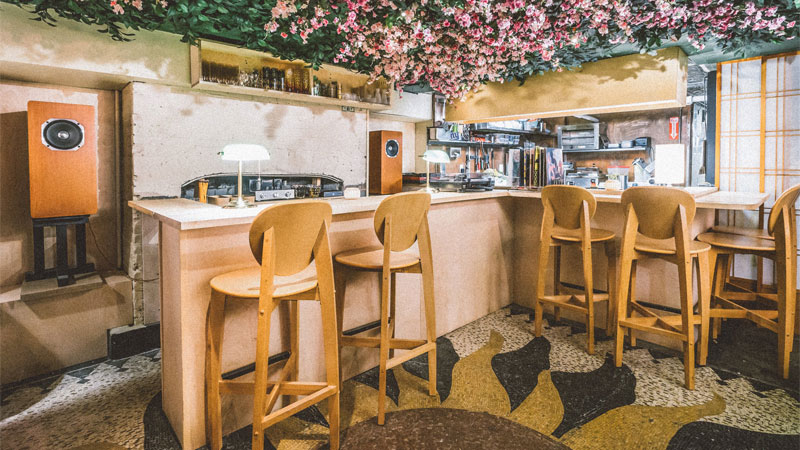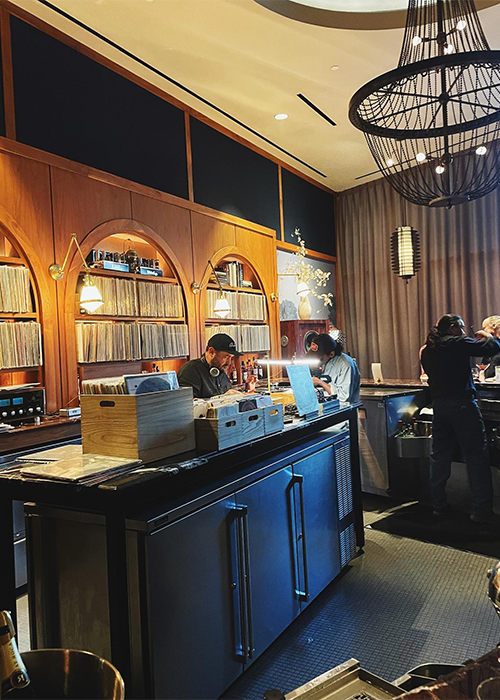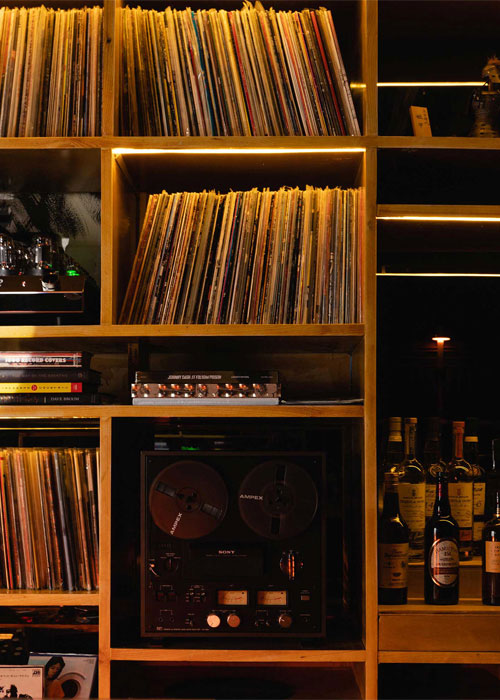The scene registers as dinner with a show, except there’s no performance. A cacophony of sound from an Arthur Russel record bounces around the room through enormous vintage speakers while 40-odd patrons keep hushed conversation around low round tables. Next up is a track from Kate Bush’s “Hounds of Love.” Weeks down the line, the bar, In Sheep’s Clothing, will host a dedicated listening session where a packed house will hear that entire album while seated in silence. The room, with its cork walls, feels more like a recording studio than a music venue. Past the impressive audio setup, there’s even a place to cozy up and order a drink, too.
Welcome to the American Hi-Fi bar.
Bars where analog music takes the spotlight go by varying names: record bar, music bar, DJ bar, and listening bar to name a few. “Hi-Fi bar” tends to be a label affixed to more and more of these types of establishments. The designation suggests that it’s not just vinyl on deck, but custom recording studio-caliber speakers as well, capable of piping out music that sounds wildly more vivid than the kind of compressed digital audio we’ve largely become accustomed to.
Don’t Miss A Drop
Get the latest in beer, wine, and cocktail culture sent straight to your inbox.
But is it quite so easy to brand, market, and lump any bar space into this growing trend solely by the presence of a flashy sound system alone? Or are there more diffusive elements at play — and just how did we get here?
Jazz Kissa: The Original Hi-Fi Bar
Identity distinctions aside, all modern Hi-Fi bars owe a great debt to the proliferation of the jazz kissa in post-war Japan. The kissa functioned as a humble, cozy space that served simple drinks and showcased international jazz records as vinyl was prohibitively expensive and home sound systems made impractical by the tight living quarters of dense cities like Tokyo. Speaking voices were meant to be kept low or non-existent to shift attention to the music.

Philip Arneill, a Belfast-based photographer who lived in Japan for decades, documented the legacy of the jazz kissa alongside journalist and fellow jazz enthusiast James Catchpole in their book “Tokyo Jazz Joints.” Arneill explains that they coined the term “jazz joints” to articulate a space that is not primarily a bar, as “kissa really means coffee shop; they’d have alcohol, but the main draw for these places wasn’t necessarily to drink, it was to listen.”
While the old-school orthodoxy of the jazz kissa is largely going out of fashion, a tendency to feature a vinyl soundtrack has seeped into all manner of Japanese bars, from raucous dives to mixology dens. The mid-2010s witnessed an explosion of these kinds of bars worldwide, especially in the United States, where the concept of the American bar has long acted as a sponge that interprets and reconstitutes disparate international influences. The cosmopolitan hubs of the San Francisco Bay area (Bar Shiru) and New York City (Tokyo Record Bar) saw a first wave of sorts while more recent openings like Austin’s Equipment Room and Denver’s ESP HiFi point to the Hi-Fi bar’s widening appeal. More and more, spots reflective of their locality and music legacy have popped up in cities like Detroit (Griot Music Lounge) and Oceanside (Sound by the Sea). It feels as if almost every medium to large city in America will soon become home to at least one.
While the jazz kissa originated out of necessity, the appeal of a Hi-Fi bar today is largely driven by novelty and leisure. American Hi-Fi bars sell themselves as alternative spaces to socially engage with music altogether, a kind of resistance to the gloat of bombastic venues like clubs or lounges along with the dreadfully maximalist fusion of the two: the clubstaurant.
The cocktail revival itself was predicated on restoring dignity to the craft as an alternative to the status quo of bars putting out a mediocre product. The American Hi-Fi bar trades in a similar appeal to tactile authenticity, bringing record-head and audiophile culture into the drinking environment. Like the best independent record stores, many music-minded bars are embracing an ethos of discovery and community. Depending on a combination of design choices, service styles, and programming choices, the Hi-Fi bar can become a hub for a variety of subcultures and interests — a bar with record-store values.
“We operate on bigger tickets rather than on volume, which is the result of being able to provide the kind of personalized service you get at a great cocktail bar.”
Arneill illuminates a similar social dynamic unique to the kissa heyday, noting that “while most owners oversaw everything to do with the place, some establishments had designated sessions to allow people to come down together and share records, kind of like a book club.”
To Hear More, Say Less
A bench test for the type of experience a Hi-Fi bar offers might start with measuring how well one can hear their own voice. Conversations in loud restaurants eventually succumb to the attrition of a playlist on repeat. Hi-Fi speakers are several times larger than typical commercial speakers, but actually perform suboptimally when volume levels are maxed out. They make it possible to clearly hear both music and your company at the same time.

Nashville’s forthcoming Bar Continental, which directly cites the jazz kissa as an inspiration, will play selections from chef Sean Brock’s personal record collection at different volume levels depending on the seating section. This approach offers tailored spaces for those who may prefer to linger and actively listen to the music. The idea of slowing down and drawing out an experience has long been antithetical to the American restaurant model of high turnovers.
“The very fact of opening a jazz kissa was actually quite countercultural,” Arneill says. “It was a conscious decision by the owner to step outside the Japanese mainstream, as they were working odd hours, operating their spaces out of love for music and not for profit.”
While opening a bar with a vinyl obsession in contemporary America hardly registers as an act of rebellion, many owners are turning hard against the notion that the survival of a music venue solely relies on high turnover. “We operate on bigger tickets rather than on volume, which is the result of being able to provide the kind of personalized service you get at a great cocktail bar,” says Gil Borenshtein, owner of Miami Sound Bar, the second Hi-Fi bar following Dante’s HiFi to recently open its doors in Miami. “The DJ is just one arm’s length away from the bartender, and the vibe they create together makes people want to linger at the bar longer.”
In Sheep’s Clothing in New York City, as was the case in its aforementioned Los Angeles outpost, takes a hybrid approach to music curation and service, where the line between DJ, server, and bartender is blurred. “We specifically hire people with music knowledge, not necessarily based on their bartending experience,” says founder Bryan Ling, whose curatorial sensibility is summed up by the project’s mission: “to hear more, say less.” The result is a kind of softly cultish experience where seemingly unstressed staff curate a vibe by quite literally having their hand on the music, manifesting drinks in one and intuitively flipping record sides over with the other.
Rituals Old and New
Certain service rituals that originated in Japanese bars, like displaying the sleeve of the record on deck prominently on the bar or lighting incense throughout service, are welcome aesthetic touches that lend a sense of place and purpose to the Hi-Fi bar. But American bars have the burden of developing their own customs if they want to resemble something other than an exported version of an increasingly mainstream trend.
Chris Manak, best known as “Peanut Butter Wolf” and founder of Stones Throw Records, opened Gold Line in 2019 with no intention of replicating listening bar traditions from abroad when they “essentially don’t exist here.”
“In Japan, you find places where one person runs everything, from the track selection to the drink making,” he says.
Manak describes how a more laissez-faire approach to day-to day curation better fits in with the tendency of Americans to bar hop throughout an evening, even as he observes that “sometimes people have a drink here, go to a concert down the street, then realize they can come back here to listen to more music.”
Every record gets air time at Gold Line, the result of a time-consuming rotation process. Manak laments the soulless feel of a place that “fills out their shelves with dollar thrift store finds and then books a DJ who shows up only to play their own records.” A DJ at Gold Line has Manak’s personal collection, which runs well over 11,000 records, at their fingertips. They just have to abide by one house rule: If a DJ brings in their own choice of LP to the bar, then it must be absorbed into the bar’s permanent rotation.
When building out In Sheep’s Clothing, Ling leaned into minimalism with decor, knowing he didn’t want to attempt to replicate the lived-in feel of an old jazz joint. He was more focused on where he could implement a number of small things that remind people why they’re there: to listen. One of these innovations is a ritual that borrows from live music performance: replacing the perfunctory process of last call with a last song.

The first time I stayed at the Los Angeles outpost of In Sheep’s Clothing until last call, I was with a friend who was going through a rough patch. Near closing time, our bartenders let us know that service will end with a final track and encouraged us to pause and join the staff in a focused listening session. They also discreetly dropped the check. While we hadn’t resolved our conversation when the last song came on, my friend was overcome with a sense of peace by the time the lights went up. As if it were the end of a theatrical performance or a movie, everyone gathered their things, got up, and left. I had never witnessed a more civil nor cathartic last call in a bar.
Reverence Rather Than Trend Chasing
Hi-Fi bars can express reverence in different ways, sometimes at odds with the consistency we often demand of bars and restaurants. Some that are packed to the brim and buzzing on weekends also host listening sessions where entire albums are listened to in near silence. We also can’t demand verisimilitude of a bygone era. As Arneill puts it, “you can’t replicate the original jazz kissa. They’re so fixed to their cultural and social element.”
The American Hi-Fi bar, with its alternating embrace of trends and tradition, is breathing new life into a vinyl subculture that is often associated with gatekeeping and elitism. As Manak shares his desire to imbue Gold Line with a legacy of fostering talent, he admits with a grin that, “It turns out that a lot of people we book … who are hearing these records for the first time are teaching me new things by experimenting with my own library.” He winces while admitting he “never anticipated how scratched up my records would get by doing this, but it’s a price worth paying to see how creative people can be.”
In Sheep’s Clothing shuttered its Los Angeles location in 2020 due to the pandemic. Ling made a decision to keep the spirit of the bar alive by revamping its website to highlight album releases, playlists, and international Hi-Fi bars. This pivot made Ling realize that “the only way that we can get close to our intention is if we put energy into programming.” The community networking approach evolved to the point where the project had become more than just a bar. Dedicated listening pop-ups soon filled houses regularly. In Sheep’s Clothing lives on in New York adjoined with Port Sa’id, holding dedicated listening sessions as part of its Monday afternoon programming where some patrons don’t just thank their bartender for serving them a drink, they thank them for the music.
A Hi-Fi bar with a strong sense of community does more than just bring disparate groups like bar flies and audiophiles together. It becomes a place that serves those who would rather indulge in a shared love of optimal-sounding music rather than play into the zero sum game of splitting differences over how closely a bar models a bygone era. Intentionality makes all the difference in where and when trend fatigue sets in. Ling is optimistic about where the Hi-Fi bar phenomenon is going, emphatically insisting that “there can’t be enough of these places if they’re done for the right reason.”